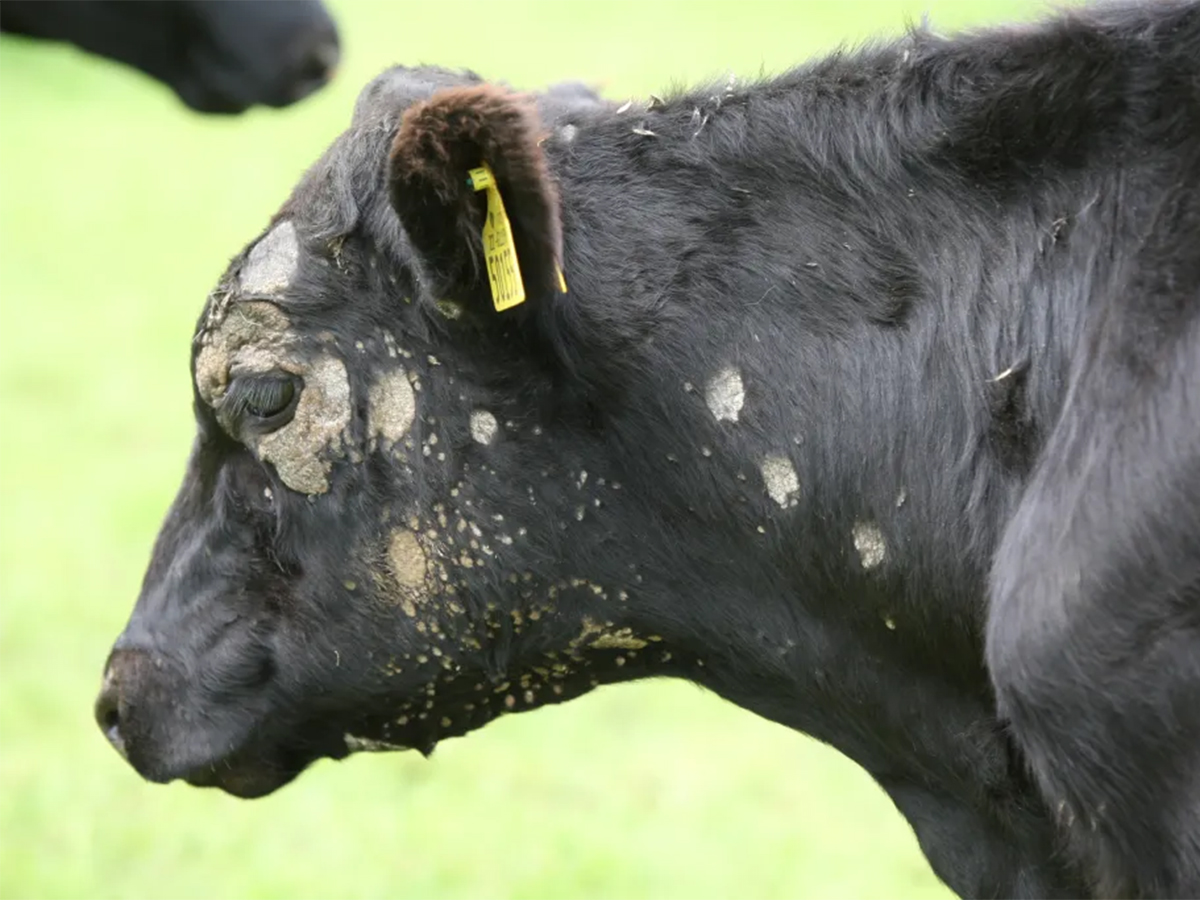UPDATED: August 21, 2025 – Ringworm can be a common condition, especially in young stock during the winter. It is caused by several fungi that are fairly widespread in the environment.
Ringworm is usually not a big concern, except for two reasons:
- It is a zoonotic disease, which means humans can contract it.
- It is a significant problem for show cattle, 4-H calves and purebred breeders exporting cattle.
Ringworm develops as crusty circular lesions with hair loss, starting primarily on the eyes and face. Most animals can contract ringworm, although it is more common in younger ones that haven’t been previously exposed. It can appear in mature stock in isolated herds where it has not been present for several years. The animal develops immunity once it contracts ringworm.
However, mature cattle are also less predisposed because they don’t have the stressors of rapid growth, weaning and parasite burdens that weaken the immune system and healthiness of the skin, which all can contribute to developing ringworm if the spores are present.
Read Also

Charges laid after cattle theft
Saskatchewan RCMP lay two charges against a man after six cattle went missing.
Prevention of ringworm
Healthy skin is a great barrier against ringworm. Vitamins A and D are necessary for healthy skin, so a common supplementary treatment is one shot of these vitamins to boost skin health.
Vitamin D is present in sunlight, which helps kill this organism. That’s why cases crop up in the winter and often disappear spontaneously in the summer. If ringworm develops in a commercial herd, the decision on whether to treat rests on how much of the body is affected.
Ringworm is of no concern to the animal if it is in small patches confined mainly around the eyes or on the face and neck. Weight gains will be normal and there is no more susceptibility to other diseases. However, animals have some distress if lots of ringworm develops over the rest of the body. They should definitely be treated. Ringworm is a relatively slow infection to contract so likewise it is a slow thing to eliminate. I believe producers have a tendency to treat at a higher frequency than necessary. One or two treatments at weekly intervals are usually all that is necessary.
The animal is on the road to recovery if the crust is not redeveloping and the skin looks healthy with small hairs starting to grow back. It will take quite a while for the hair to completely fill in. Show and 4-H animals should look normal three to four weeks after the last treatment.
Treatment of ringworm
Treatment consists of removing the crusty material with a stiff bristled brush, but don’t use the brush for anything else. This should reveal a red inflamed underside that allows any treatment applied to contact the actual ringworm fungus.
I use commercial products such as Kopertox, but they stain the hair green for awhile. Use hibitane cream, Crest toothpaste or thiabendazole deworming powder if shows or displays are just around the corner. I usually will repeat a week later. The beauty of these other products is they have a more natural white-to-creamy colour and can be removed if necessary.
Ringworm in humans
Humans can contract ringworm from cattle or other species. Practice strict biosecurity measures, wear gloves and wash well after treatment. Put brushes in a plastic bag and label so others don’t mistakenly use them for other procedures.
Ringworm spreads by direct contact so regular brushes, halters, saddles and saddle blankets can easily spread it from one animal to another. The herd has probably been exposed by the time ringworm is visible, so I don’t believe isolation is usually necessary.
As a preventive measure following bad years, producers can disinfect rub areas by spraying compounds such as formaldehyde or phenols. These organisms are hardy against climatic conditions so complete disinfection in an outside environment is pretty much impossible.
Vaccines are effective but expensive and really have a place only in expensive show stock where owners want to minimize the likelihood of ringworm developing just before show season. Otherwise, there are many more fatal or production limiting diseases we need to focus on in beef cattle production.
The important thing to remember is ringworm is mostly a blemish that can be treated. Be careful not to contract it because human cases are harder to clear up. I have had it once as a kid and three times in a 30-year veterinary career.

















